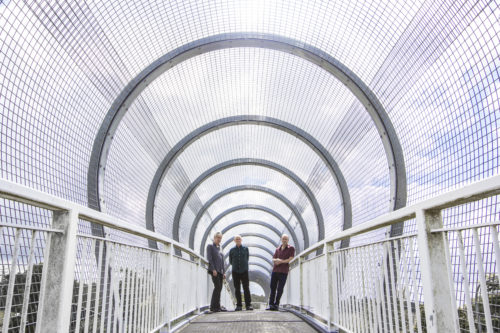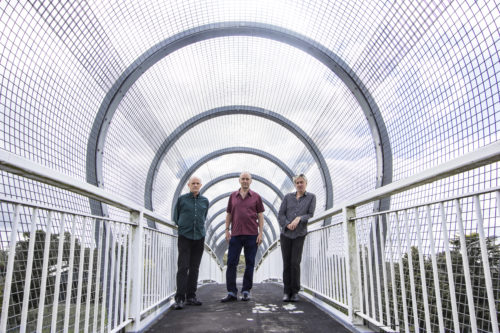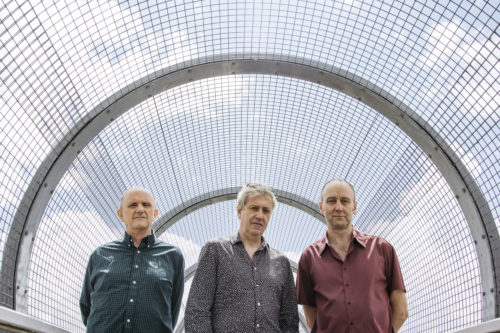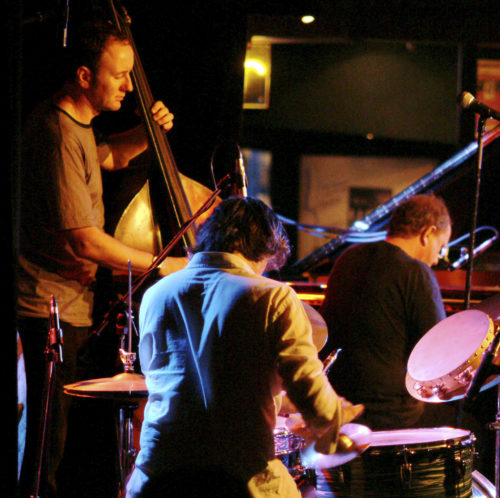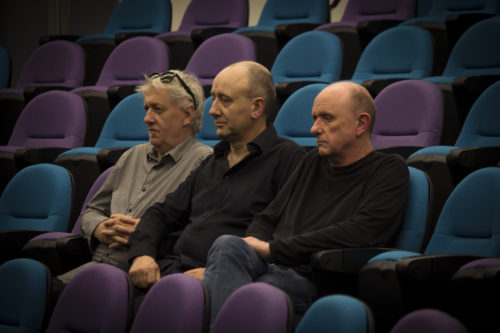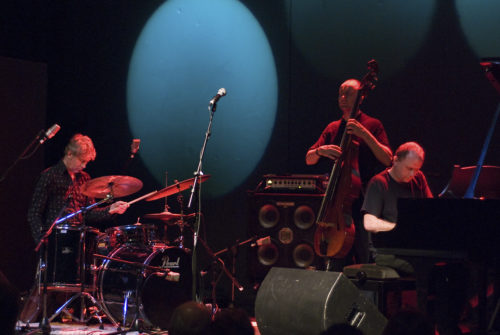Depuis bientôt 35 ans, The Necks, brelan d’improvisateurs virtuoses venus d’Australie, s’attache insubmersiblement à faire atteindre à la forme canonique du trio jazz (piano/contrebasse/batterie) des horizons insoupçonnés, proches de la musique répétitive autant que du post-rock. En attendant de revoir sur scène en Europe ce groupe devenu culte, tentative d’épuisement d’un morceau atypique.
C’est grâce à un article de Pierre-Yves Macé pour la revue Mouvement, quelque part vers 2005-2006, que j’ai découvert The Necks, trio formé en 1987 en Australie par Chris Abrahams (piano, orgue Hammond), Tony Buck (batterie, percussion, guitare électrique) et Lloyd Swanton (contrebasse, guitare basse), tous trois natifs du début des années 1960 et déjà alors jazzmen aguerris.
Et c’est peu après, grâce à ce morceau, Abillera, que je suis vraiment entré dans cette musique enchanteresse, « aux confins du jazz, du kraut et du post-rock, de la musique répétitive et de l’ambient » (Pierre-Yves Macé ).
Abillera, troisième et dernier titre du CD Chemist (2006), est sans doute un morceau atypique dans la discographie de The Necks (on y reviendra) ; il n’en demeure pas moins, pour moi, l’une des plus épiques chevauchées dans le monde de l’électricité, des harmoniques et du son – une sorte de rollercoaster sonique (après les montagnes russes, les cimes australiennes), de maelstrom psychoacoustique – qu’il m’ait été donné d’écouter. Commençons par là : écouter.
Tentative d’épuisement (attention, spoiler ; on peut aussi préférer écouter directement le morceau ci-après) :
Abillera (1) débute par un solo de contrebasse de plus de trois minutes; solo abrupt, abstrait, boucle répétitive, interminable, lente et hiératique de notes graves en pizzicato dont on mettra du temps à comprendre la présence, tant il contraste avec ce qui va suivre ; solo qui finit par se fondre progressivement dans le silence… d’où immédiatement après, et non moins progressivement, émerge un flot sonore fait de nappes (et de boucles) de piano et de guitare électrique allant s’épaississant, s’intriquant de manière à forger un engrenage de résonances en perpétuel mouvement.
On pense à Steve Reich, à une sorte d’application polyphonique et psychédélique de sa technique du déphasage. Peu à peu les matières sonores s’y agglutinent et fusionnent, formant comme une lave qui finit par déferler à 7’00’’ avec l’entrée soudaine de la batterie, bille en tête, implacable quoique claudicante, dont le tempo rapide et la métrique impaire déroutent autant qu’ils galvanisent. De polyphonique et psychédélique, l’atmosphère se fait répétitive et hypnotique, les collisions successives des instruments et des timbres, décuplées par les effets de studio (reverb, panoramiques, etc.) créant de puissants phénomènes (psycho)acoustiques, même si c’est la guitare électrique qui a, il est vrai, le rôle principal.
Du moins jusque vers 10’00’’ où elle se tait, non sans avoir exposé une suite de motifs (de riffs) que l’on retrouvera par la suite.
C’est alors seulement que l’on réalise la présence de la contrebasse (qui en réalité était déjà là depuis longtemps, apparue en même temps que la batterie). Et que l’on comprend cette introduction, ces trois premières minutes du morceau, ce motif de basse joué solo était juste une manière d’exposer préalablement une partie du squelette du morceau, une boucle qui ici, prise non plus isolément mais parmi les autres (la boucle de la batterie, celle de l’orgue Hammond), prend un relief différent. (Et donne envie de remettre le morceau au début pour accompagner cette contrebasse solitaire, jouer par-dessus elle, mentalement ou en frappant le rythme sur ses genoux, les séquences encore inaudibles qui plus tard la mettront en mouvement.)
A 11’04’’, Abillera prend soudain une nouvelle dimension, subit une nouvelle métamorphose : c’est une explosion rock qui s’égrène en multiples secousses, au fil de laquelle, quatre minutes durant, tous les instruments vont dérouler leurs motifs/boucle en une masse polyphonique de plus en plus dense, de plus en plus chargée. Dans les haut-parleurs et les oreilles les timbres se répandent et se répondent, s’entrelacent et se confondent : à des guitares héroïques fait littéralement écho un piano qui se diffracte et s’accélère en arpèges liquides et répétitifs. Bientôt rejoint par un orgue fantomatique, cependant que Tony Buck progressivement alourdit sa frappe en un crescendo impalpable mais implacable. Ainsi peu avant 15’00’’ le morceau atteint-il (de nouveau !) son climax, avec l’arrivée d’une guitare basse métronomique qui amplifie l’effet puissant des riffs de guitare.
Ce point (15’00’’) marque aussi le début de la dissolution progressive de la batterie, suivant un interminable fade out de plus d’une minute, magnifique, magique. Magique aussi parce qu’il est comme une sorte de reflet technologique du crescendo purement instrumental, vivant, acoustique qui venait de précéder (on y reviendra).
Comme si cette batterie n’avait servi qu’à propulser, mettre en orbite les boucles qui à partir de 16’25’’ commencent à tourner ensemble et sur elles-mêmes.
C’est l’acmé, le véritable climax d’Abillera.
Le piano prenant l’ascendant, déroulant comme des colliers de perle hyalines ses motifs motoriques et wagnériens, puissamment consonants, comme un John Adams perdu dans le studio de Phil Spector. Suspension du temps, dilatation des sens. Jusqu’à ce que l’ensemble finisse, non moins progressivement, par regagner le silence. Ce silence dont, à peine vingt minutes plus tôt, il semblait être né.
Jugez-en vous-même :
Abillera est, on le disait en préambule, un morceau atypique, finalement assez peu emblématique de la discographie et de la démarche de The Necks. D’abord parce qu’avec ses 19’53’’, même si c’est le plus long des trois titres de Chemist, il fait finalement partie des morceaux les plus courts (!) du trio. De Sex (1987) au magnifique Three (2020), la plupart des albums de celui-ci (environ 25) consiste en un unique morceau de plus de 45 minutes, improvisé en live et éventuellement retraité en studio.
Exception notable : l’émouvant Next, deuxième album des Necks, paru 1990, et constitué de six morceaux d’une durée variant entre 5 et 20 minutes.. Emouvant, parce qu’il nous permet d’entendre Abrahams, Buck et Swanton encore à leurs débuts, et de mieux prendre la mesure de leur entreprise démesurée : pousser dans ses plus ultimes retranchements la forme canonique du trio jazz piano/contrebasse/batterie, jusqu’à l’amener – et cela est justement flagrant dans Abillera – aux confins de la musique « savante » (et plus particulièrement du courant minimaliste), du kraut- et du post-rock.(2) En témoigne ici, en 1990, Pele, morceau extraordinaire, déjà visionnaire, qui semble brasser des décennies d’histoire du jazz tout en nous faisant transiter par une multitude d’état, d’une entame be-bop à un final tribal en passant par de nombreuses phases statiques, où le trio s’arrête sur une boucle pour en exploiter toutes les vertus harmoniques et (poly)rythmiques, l’ensemble sonnant comme une sorte de version jazz, embryonnaire, d’Abillera :
Si Abillera est un morceau atypique, c’est aussi parce que sa force tient autant à la qualité de sa « composition /improvisation» qu’à celle de sa production, cette dernière devenant une composante essentielle de l’oœuvre. Rarement autant qu’ici les Necks se sont plu à jouer des artifices du studio : Abillera est l’un des rares morceaux « maximalistes » des Necks, l’un des moins improvisés, où l’on peut entendre Chris Abrahams en même temps au(x) piano(s) ET à l’orgue, Tony Buck à la batterie ET à la guitare électrique, Lloyd Swanton à la contrebasse ET à la guitare basse… Le studio (ces fondus, ces panoramiques, ces effets d’écho, de reverb et de delay) est un protagoniste à part entière de la dramaturgie musicale, de la transe qui est ici à l’œuvre – de la composition (mêrme si, chez The Necks, celle-ci résulte d’une improvisation permanente). Si ce morceau est peut-être le plus « rock » des Necks, c’est aussi parce que c’est le plus « edité », celui qui a fait l’objet, ai-je l’impression, du plus gros travail de re-recording et de montage. L’exposition en solo du motif/de la boucle de contrebasse au début, très atypique de la part The Necks, peut être entendu a posteriori comme une sorte de prélèvement, de sample, copié-collé plutôt que joué. J’adore également la manière dont, autour de 15’00’’, au crescendo « joué » de la percussion répond sa version « artificielle », technologique, un decrescendo qui n’est pas l’effet de l’instrumentiste, mais celui de l’ingénieur du son baissant imperceptiblement la courbe de volume de sa prise enregistrée…. Autant de détails qui, en rendant à mes yeux ce morceau encore plus intelligent, le rendent à mes oreilles encore plus intelligible, jouissif.
Cette proéminence du travail du studio est d’autant plus remarquable, et singulière, que ce sont les concerts qui ont fait la réputation de The Necks, et expliquent – à juste titre – le culte de plus en plus fervent qui s’exerce autour de ce trio dont les membres poursuivent par ailleurs de nombreux projets parallèles. Aucun, en effet, des concerts que j’ai vus ne fut semblable à l’autre, tout simplement parce que le trio conçoit chacune de ses apparitions comme une performance liée aux propriétés acoustiques et esthétiques du lieu qui l’accueille, à l’atmosphère du soir et à son état d’esprit du moment : je garde un souvenir particulièrement fort de leur passage, le 14 avril 2016, au Collège des Bernardins, où les musiciens parurent ce soir-là nouer une conversation sans paroles, verticale, ascétique et acédique, avec les voûtes de pierre qui les surplombaient – ce soir-là, leur état d’esprit, plus encore que d’ordinaire, fut un état de grâce. Ces apparitions procèdent, de la part des musiciens comme des auditeurs, d’une miraculeuse aptitude à s’abandonner à l’instant et à remettre en jeu leur vocabulaire, leurs habitudes (de jeu comme d’écoute). En cela, mais aussi par sa radicalité, son intransigeance et son obstination, le cheminement des Necks me fait penser, dans le domaine du rock, à celui d’un groupe comme Swans (3). Il semble n’avoir d’autre but, ce parcours, de se servir d’un style le jazz, le rock…) pour fouiller toujours plus profondément les arcanes du phénomène musical, de renouer avec l’énergie primale de la matière sonore en un corps-à-corps aussi fervent que patient avec la musique, et ainsi emmener ce style ailleurs, à cet endroit où les questions d’esthétique n’ont plus cours ; d’inviter, sur scène comme sur disque, à abandonner ses repères, à se disposer à la transe.
The Necks devraient être de retour sur les scènes européennes cet automne.
David Sanson



)
